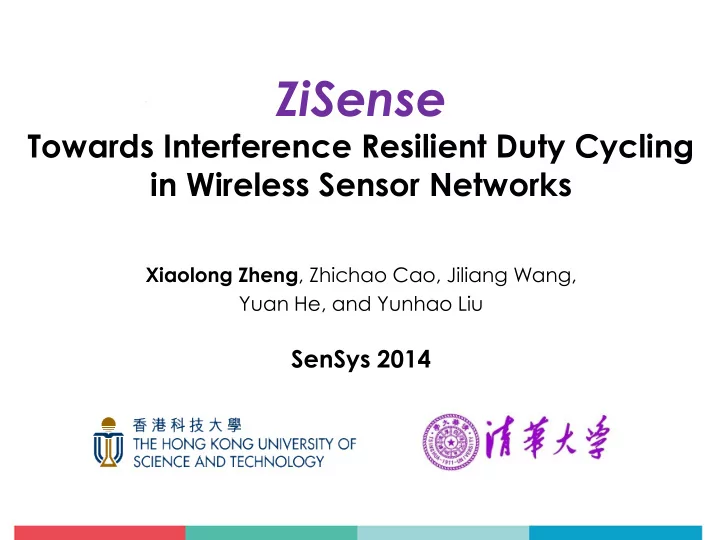

ZiSense Towards Interference Resilient Duty Cycling in Wireless Sensor Networks Xiaolong Zheng , Zhichao Cao, Jiliang Wang, Yuan He, and Yunhao Liu SenSys 2014
Existing low-power method • Radio : major source of energy consumption • Duty cycling: Low Power Listening – Schedule nodes: sleep (radio off) or wake up (radio on) ACK D Radio on C CCA Data packet D D D Sender D C C Receiver 2
CCA (Clear Channel Assessment) • Decides a node wake up or not – Energy detection by threshold – High energy on channel Busy channel Possible transmissions Wake up nodes – Effective energy efficient method in clean environments Interference is ignored! 3
Channel overlapping 1 2 3 77 79 Bluetooth Channels 2401.5 2480.5 Microwave oven 2445 2465 No clean channel away from interference all the time 4
Impacts on LPL • False wake-up problem – Heterogeneous interference unnecessarily wakes up the receiver! Radio on C CCA I Interference C Sender C C Receiver Time out I I I I I Interference False wake-up, energy waste 5
Adaptive Energy Detection Protocol [1] Poll CCA pin N times RSSI wakeup threshold 0 0 0 1 1 1 1 1 1 1 1 1 0 0 0 K readings ≥ threshold wake up RSSI wakeup threshold 0 0 0 0 0 0 1 0 0 0 0 0 0 0 0 No wake-up 6 [1] Mo Sha et al. Energy-efficient low power listening for wireless sensor networks in noisy environments , IPSN’13
Limitation RSSI MIN packet wakeup threshold MAX noise Min packet > Wake-up threshold > Max noise RSSI MAX noise MIN packet 7
Key insight • Energy detection is too simple to filter out the interference – High energy on channel Busy channel possible ZigBee transmissions – No matter how good the threshold is set, false wake-up problem still exists Can we recognize ZigBee by some other information instead of energy? 8
Roadmap • Background • Motivation • Observations • Design of ZiSense • Evaluation • Conclusion 9
Recognize ZigBee • Limited information provided by the radio hardware – RSSI (Received Signal Strength Indicator) • Key observation: – Different technologies in 2.4GHz leave distinguishable patterns on the time-domain RSSI sequence . 10
Observations 11
Feature #1: on-air time Valid range of Shorter on-air time on-air time longer on-air time 12
Feature #2: packet interval Fixed packet Shorter packet interval interval longer packet interval 13
Feature #3: PAPR (Peak-to-Average Ratio) Large variation Flat sequence 14
Feature #4: RSSI < noise floor FALSE TRUE 15
Roadmap • Background • Motivation • Observations • Design of ZiSense • Evaluation • Conclusion 16
ZiSense: Design • Sense ZigBee and wake up nodes only when ZigBee signal is detected. 17
ZiSense: Identify ZigBee • Adopt the decision tree as the classification algorithm 18
ZiSense: Identify ZigBee • Rule-based identification algorithm – Simple yet effective, because features are stable – Universal to directly use in another system, without training . • Four conditions as rules – C1 : PAPR ≤ PAPRZigBee; – C2 : Ton ≥ Tmin; – C3 : | MPI − MPIvalid | ≤ δ; – C4 : UNF = FALSE. • Valid conditions (C1, C2, C3, C4) in strict conformance with valid ZigBee sequence – (T,T,T,T) – (F,T,T,T) deal with some corrupted features – (T,F,T,T) 19
ZiSense: Identify ZigBee • Decision tree trained by C4.5 20
Identification Accuracy Algorithm TP rate FN rate TN rate FP rate Rule-based 97.5% 2.5% 97.6% 2.4% Decision tree 97.3% 2.7% 99.1% 0.9% • TP(True Positive): correctly recognize ZigBee signals • FN(False Negative): missing valid ZigBee packets • TN(True Negative): correctly recognize non-ZigBee • FP(False Positive): false wake-ups 21
ZiSense: Identify ZigBee • Comparable accuracy – Compared with specially trained decision tree • Effective algorithm: – False positive (false wake-up) rate: 2.4% – False negative (missing packet) rate: 2.5% • General algorithm: – Stable features which are extracted from hardware and standard specifications – Directly used in other systems 22
Roadmap • Background • Motivation • Observations • Design of ZiSense • Evaluation • Conclusion 23
Different Interference Type • False wake-up ratios under different heterogeneous interference environments 24
Different Interference Intensity • Duty cycle = radio-on time / total time 25
Integrated with Routing Protocol • Integrated with CTP – 41 nodes deployed in a 50*100m2 office – Each method runs 24 hours 26
Integrated with Routing Protocol • Integrated with CTP – Improve energy efficiency without extra overhead 27
Side effects • NO Side effects End-to-end ETX Routing link RSSI 28
Conclusion • ZiSense: interference-resilient duty cycling technique – Solve false wake-up problem – Recognize valid ZigBee signals by only RSSI sequence • Keep low energy consumption, ZiSense consumes – BoX-MAC-2: 24% (extreme case) and 38% (office) – AEDP: 27% (extreme case) and 50% (office) 29
Thank You!
Recommend
More recommend